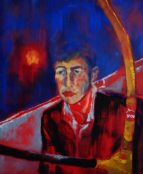[dropcap style=”font-size:100px; color:#992211;”]K[/dropcap]angaroos use their tail as a fifth, middle leg, it seems.
‘Are you going far, queer fellow?
How’s your middle leg?
Got a match on you?
Eh, come here till I stiffen it for you.’
– James Joyce, Ulysses
(Sorry, couldn’t resist.)
A Simon Fraser University study on how kangaroos use their tails as a ‘fifth’ leg is providing new insight into the diversity of biological movement, and specific insight into why we walk the way we do.
Published in the Royal Society journal Biology Letters, the study, led by professor Max Donelan of SFU’s Locomotion Laboratory, found kangaroos, commonly viewed as hoppers, move with a “pentapedal” gait, planting their tails on the ground in combination with their front and hind legs.
“We measured the forces the tail exerts on the ground and calculated the mechanical power it generates, and found that the tail is responsible for more propulsive force than the front and hind legs combined,” explains Donelan, an associate professor in the Department of Biomedical Physiology and Kinesiology (BPK).
“It also generates almost exclusively positive mechanical power, performing as much mechanical work as a human leg when walking at the same speed. Their muscular tail is used to propel and power their motion—just like a leg.”
Measurements were carried out at the University of New South Wales in Sydney Australia back in 2001, but the researchers were only just recently able to analyze them properly, thanks to innovations by Donelan’s collaborator, Dr. Shawn O’Connor.
“One of the central findings of our human walking research is that it is very important to time the push-off of your back leg to make walking less effortful,” says Donelan, founder and scientific advisor to Bionic Power. The university spin-off company develops energy harvesting technology for those who depend on portable power.
“People recovering from strokes or spinal cord injury can’t do this as well because their legs are partially immobilized, making walking more effortful.”
Kangaroos, meanwhile, have very short front legs that can’t be used to push off. “The timing and position of the tail, on the other hand, is perfect,” he says. “So, we wondered if they are able to use their tail just like a leg to push off and power their walking.”
What’s remarkable about this, suggests Donelan, is that the tail is anatomically quite different, being made up of more than 20 vertebrae taking on the roles of our feet, calves and thigh bones. “Animals have discovered many uses for their tails,” he says, “but as far as we know, this is the first use of one as a leg.”
Beyond better understanding kangaroos’ movements, the research shows how important it is to push-off and help to redirect the body’s velocity when transitioning from one stance limb to the next, Donelan adds. “We know healthy humans do this nearly perfectly. We know that people with gait disorders and disabilities don’t do it as well, which increases the effort required for them to walk.
“Based on our original human research, fellow scientists and engineers have have built prosthetics and exoskeletons that help improve ability and make walking easier. And now we know that it is important enough that kangaroos have harnessed a limb originally evolved for swinging from trees to serve this role as functional fifth leg.”
Unusual gaits by unusual animals, such as pentapedal walking by kangaroos, provide insight into the breadth of solutions available to the same biomechanical problem, notes Donelan, who has also studied the movement of shrews, cats, crocodiles, giraffes and elephants.
And what’s not to find intriguing about kangaroos? “Their hopping is incredibly fast, powerful and efficient. Their walking, on the other hand, is as awkward as their hopping is graceful, but underlying the walking is this entirely new use for a tail. Biomechanically, it is all fascinating.”
Source: Simon Fraser University
Photo: Freedigitalphotos.net/Michelle Meiklejohn

Some of the news that we find inspiring, diverting, wrong or so very right.



















